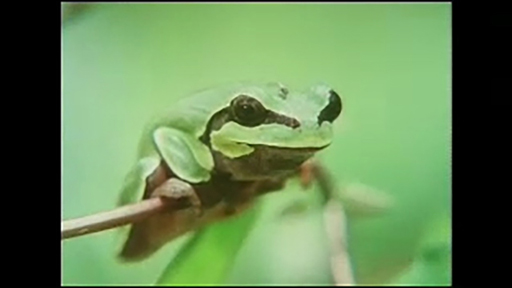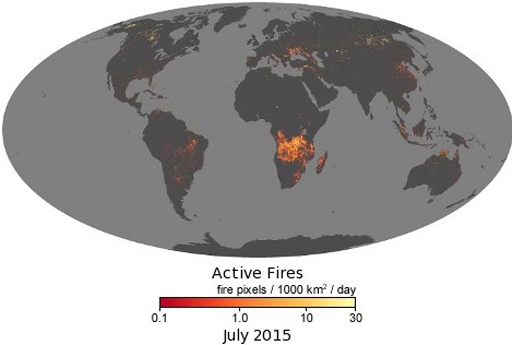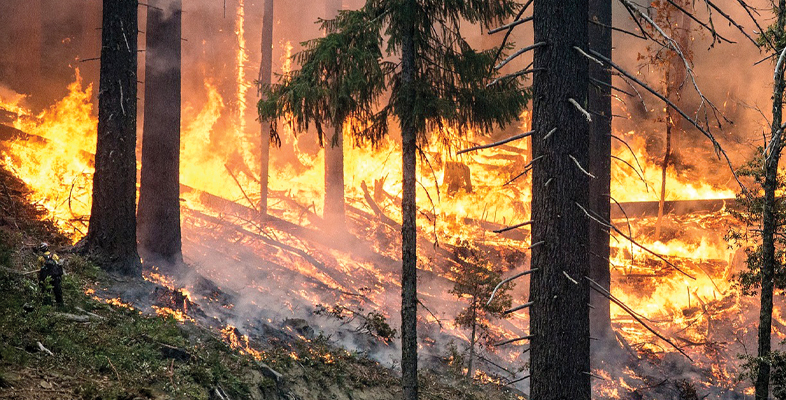1.1 The effects of fire on an ecosystem
Given the 2020 wildfires on Australia and the obvious devastation they have caused, the perception of wild fires is often that they are destructive disturbances. However, wildfires are an important part of healthy ecosystems and play a key role in shaping the composition, structure and function of many ecosystems on Earth.
Activity 1 The effects of fire on an ecosystem
Watch Video 1, which is the excerpt ‘Fire as an agent of perturbation’ from the BBC programme The Living Planet, Northern Forests to give you an introduction to fires as an agent of ecosystem disturbance. As you watch the video, think in particular about the effects of fire on:
- the dominant kind of vegetation
- the overall biodiversity.
You should also consider what effects the frequency of fire might have on:
- the structural complexity of the habitat
- the resistance and resilience of the habitat to fire, i.e. its susceptibility and the time taken to recover from fire respectively.
You should refer to the following notes and questions as you watch the video. You may like to use the text box below to record your notes.

Transcript: Video 1 Fire as an agent of perturbation, with Sir David Attenborough. Fullscreen mode is recommended (last button on right of video control bar).
DAVID ATTENBOROUGH: I’m on the borders of Florida and Georgia in the southern United States. And here, it’s very hot in the summer. And the winters are very mild, with only a few frosts, and none of them severe.
So some of the broad-leafed trees here, like, for example, this oak, don’t shed all their leaves in the autumn, but keep them throughout the year and continue growing. And these aren’t the only evergreens that are here, either. There are pines. In some parts, where the soil is very rocky, or sandy, and poor in nutrients, the pines will grow, because nothing else can survive there. But this pine forest owes its existence to another factor altogether.
[FIRE BURNING]
Oak saplings are killed within minutes by fire. But the terminal buds of young pines are surrounded by a shock of needles. They burn at a relatively low temperature. And by the time the flames have consumed them, the main fire has swept by. And the buds at the top of the stem, from which new growth will come, is still unharmed.
Fires like these are not just the work of careless people. They occur naturally. The spark that regularly sets fire to these forests is lightning. In this part of the southern states, violent thunderstorms are common. And lightning often strikes the taller trees, scoring a deep groove down the length of the trunk as it flashes down to Earth.
And this, at my feet, is the tinder which set it aflame. These are pine needles. And they’re so full of resin and they’re so dry that they flame up very easily. But the fire they produce is not very hot. And it’s also very short-lived, so that if any creature can survive for just one or two minutes, then it can survive a fire like this.
[SNAKE HISSING]
The rattlesnake, like many other ground-living animals, regularly takes refuge from the midday sun in holes. So now, it knows exactly where to go to escape the fire.
[SNAKE SLITHERING]
[BIRDS CHIRPING]
[SNAKE RATTLING]
But this hole is already occupied by its digger and owner, a gopher tortoise.
[MUSIC PLAYING]
[SNAKE RATTLING]
Rattlesnake and tortoise do not normally interfere with one another. And that seems to be the way things are going to stay. But in the back of the burrow lies another refugee, an indigo snake. And it, on occasion, eats rattlesnakes.
[MUSIC PLAYING]
But the fire is passing. And the rattlesnake can return to the forest. Some insects don’t avoid fire. They actively seek it.
Beetles find it difficult to lay their eggs in the pines, because the trees swamp them with resin. But a tree killed by fire, it can’t resist. And these beetles take advantage of the situation.
They have pits behind their legs, which are sensitive to infrared rays. And therefore, they can detect the slightest rise in temperature. And with these to guide them, they travel from all over the forest to the wake of the fire and arrive in hundreds.
Quickly, they mate. The females crawl all over the scorched trunks, seeking crevices in the bark into which they can lay their eggs, so ensuring that they’re grubs will have some nice nutritious bark to chew. As insects assemble in the burnt forest, the insect eaters follow.
The oak toad almost exactly matches the colour of the charred forest floor. Other more conspicuous hunters wait on newly-emerged shoots. Within a couple of months of a summer fire, the forest has more than recovered. It is rejuvenating. The fire has cleared away the old growth on the ground, and by reducing the pine needles the ash, has released their nutrients into the soil. And now the ground sprouts more flowers than at any other time.
[BEES BUZZING]
[BIRDS CHIRPING]
Because of regular fires, big bushes can’t establish themselves here. So swampy areas are not colonised and sucked dry by them, as happens elsewhere. And open marshes remain where pitcher plants can grow and where frogs can swim and breathe. Indeed, one species of frog lives no one else but in these pools in the American Pine Barrens.
[BIRDS CHIRPING]
[FROGS CROAKING]
The woodpeckers here can’t excavate their nest in dead trees, as do woodpeckers elsewhere. For in this fire-ravaged forest, they will risk incineration. So the red coquetted woodpecker drills its holes in living pines. But the wood is so hard, it takes several woodpeckers about two years to dig the hole.
Resinous sap seeps out around the hole where the outer layers of the tree have been breached. So the birds make their hole low down on the trunk, where the inner sap-free heartwood is thick enough to accommodate the entire nest. The flow of resin is diverted to the outside by drilling pits like sap wells above and below the hole.
[BIRDS CHIRPING]
It’s in these laboriously-excavated holes that the red-coquetted woodpecker raises its young.
[BIRDS CHIRPING]
The holes are very conspicuous, for each is surrounded by a sheet of yellow, congealed resin.
[BIRDS CHIRPING]
The rat snake is a great robber of nests and stealer of chicks.
[MUSIC PLAYING]
It’s an extremely skillful tree climber. Since the woodpeckers’ hole in the living tree has to be fairly low down on the trunk, it is within easy reach of the snake, and therefore, might seem to be in considerable danger. But now, the other function of all that resin, deliberately produced around the nest by the woodpecker, is about to become clear.
[MUSIC PLAYING]
[BIRDS CHIRPING]
The chemicals in the resin seem to irritate the snake beyond endurance. And it arches its body away.
[SNAKE HISSING; DAYLIGHT VISIBLE BETWEEN MIDDLE OF SNAKE AND TRUNK OF TREE]
Eventually, it’s too much.
[SNAKE FALLS OFF TREE; LANDS ON FOREST FLOOR]
[BRASSED-OFF SNAKE SLITHERS INTO UNDERGROWTH]
So fire, one way or another, influences the whole community of animals and plants in the pine forests of the South.
Sir David Attenborough introduces the excerpt by showing that there are two dominant types of tree in the woodland.
What are the two dominant types of tree in the woodland, and how do they differ in terms of their fire resistance?
Answer
They are Pinus spp. (pines) and Quercus spp. (oaks). It is pointed out that the Quercus seedlings are destroyed by fire, while the Pinus seedlings are more resistant to fire because they have a protective thatch of pine needles around the growing tips.
Quercus spp. trees are stronger competitors than Pinus spp. trees for light and nutrients.
What would happen to the dominant tree type in the woodland if fire was suppressed over many decades?
Answer
The woodland would come to be dominated by Quercus spp. trees.
Video 1 also reveals that litter composed of resin-rich pine needles is more combustible than fallen Quercus spp. leaves.
Given this fact, what would you expect to happen to the likelihood of fire starting as the time since the last fire increases?
Answer
The probability of fire starting would fall as the proportion of Quercus spp. leaves in the litter layer increased.
Conversely, in a pine-dominated woodland, the litter layer is dominated by pine needles, and the more pines there are, the more needles there are, and so the more likely it is that fires will start.
Satellite imagery now makes it possible to view the vast areas of the Earth that have been, and are currently, subjected to fire:

The map shows the locations of actively burning fires around the world on a monthly basis, based on observations from the Moderate Resolution Imaging Spectroradiometer (MODIS) [Tip: hold Ctrl and click a link to open it in a new tab. (Hide tip)] on NASA’s Terra satellite. The colours are based on a count of the number (not size) of fires observed within a 1,000-square-kilometer area. White pixels show the high end of the count — as many as 30 fires in a 1,000-square-kilometer area per day. Orange pixels show as many as 10 fires, while red areas show as few as 1 fire per day.
Many of these fires have, in recent times, been catastrophic, destroying lives, properties and infrastructure. In 2016 and 2017, large areas of Canada, the western United States, southern Europe, Greenland, Indonesia, Chile, Australia and South Africa were affected by wildfires and this trend is set to continue with rising global temperatures, something that will be returned to later in the course.
Although in some cases, the economic and social effects of wildfires can be devastating, as you saw in the previous video, fire is also an important natural ecological phenomenon, regulating and influencing community composition and ecosystem function in many parts of the world. At present, the type of community (e.g. whether grassland or forest) and the relative abundance of species present on over half the land’s surface is believed to be determined largely by the interaction of fire and climate.
